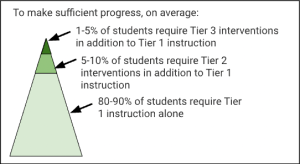Response to Intervention in Elementary Math
Link to this section
Principles of Response to Intervention Link to this section
RTI is a tiered student support system that focuses on the results of implementing instructional interventions in a model of prevention. Many times the RTI model is represented in a triangle or pyramid format, although other models are used. Each tier in the triangle represents a level of intervention with corresponding monitoring of results and outcomes.

The foundational and largest portion of the triangle (Tier 1) represents the instruction that should be used with all students—instruction based on high-quality mathematics curriculum and instructional practices (i.e., manipulatives, conceptual emphasis, etc.) and on assessments. At tier 1, a balanced set of different assessments should be used to monitor progress and allow all students to demonstrate the knowledge and skills expected by grade-level standards.
Tier 2 represents students who did not reach the level of achievement expected during tier 1 activities. Students in tier 2 should receive additional targeted instruction (interventions) using more intensive and frequent instructional opportunities and more supportive and precise prompts to students (Torgesen, 2002) in order to support students with major grade-level concepts. If further assessment such as diagnostic interviews reveals favorable progress, the students are weaned from the extra intervention.
If challenges and struggles still exist, the interventions can be adjusted or, in rare cases, the students are referred to the next tier of support. Tier 3 is for students who need more intensive levels of assistance, which may include comprehensive mathematics instruction or a referral for special education evaluation or special education services.
Read more about SFUSD Math principles and guidelines for Response to Intervention in Elementary Mathematics.
Adapted from: Van de Walle, J. et al. Elementary and Middle School Mathematics: Teaching Developmentally, Chapter 6: “Teaching Mathematics Equitably to All Children”.
This page was last updated on June 19, 2023


